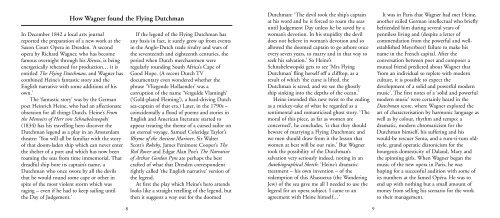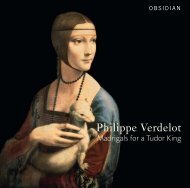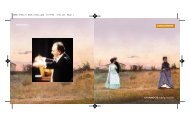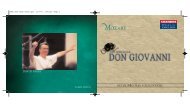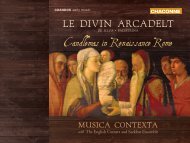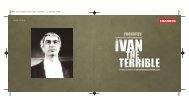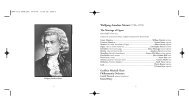CHANDOS
CHANDOS
CHANDOS
- No tags were found...
Create successful ePaper yourself
Turn your PDF publications into a flip-book with our unique Google optimized e-Paper software.
CHAN 3119 BOOK.qxd 20/9/06 12:00 pm Page 8How Wagner found the Flying DutchmanIn December 1842 a local arts journalreported the preparation of a new work at theSaxon Court Opera in Dresden. ‘A secondopera by Richard Wagner, who has becomefamous overnight through his Rienzi, is beingenergetically rehearsed for production… it isentitled The Flying Dutchman, and Wagner hascombined Heine’s fantastic story and theEnglish narrative with some additions of hisown.’The ‘fantastic story’ was by the Germanpoet Heinrich Heine, who had an affectionateobsession for all things Dutch. Heine’s Fromthe Memoirs of Herr von Schnabelewopski(1834) has his travelling hero discover theDutchman legend as a play in an Amsterdamtheatre: ‘You will all be familiar with the storyof that doom-laden ship which can never enterthe shelter of a port and which has now beenroaming the seas from time immemorial. Thatdreadful ship bore its captain’s name, aDutchman who once swore by all the devilsthat he would round some cape or other inspite of the most violent storm which wasraging – even if he had to keep sailing untilthe Day of Judgement.’If the legend of the Flying Dutchman hasany basis in fact, it surely grew up from eventsin the Anglo-Dutch trade rivalry and wars ofthe seventeenth and eighteenth centuries, theperiod when Dutch merchantmen wereregularly rounding South Africa’s Cape ofGood Hope. (A recent Dutch TVdocumentary even wondered whether thephrase ‘Vliegende Hollaender’ was acorruption of the name ‘Vergulde Vlamingh’(‘Gold-plated Fleming’), a hard-driving Dutchsea-captain of that era.) Later, in the 1790s –coincidentally a flood of poems and stories inEnglish and American literature started toappear treating the theme of a cursed sailor onan eternal voyage. Samuel Coleridge Taylor’sRhyme of the Ancient Mariner, Sir WalterScott’s Rokeby, James Fenimore Cooper’s TheRed Rover and Edgar Alan Poe’s The Narrativeof Arthur Gordon Pym are perhaps the bestcrafted of what that Dresden correspondentrightly called ‘the English narrative’ version ofthe legend.At first the play which Heine’s hero attendslooks like a straight retelling of the legend, butthen it suggests a way out for the doomedDutchman: ‘The devil took the ship’s captainat his word and he is forced to roam the seasuntil Judgement Day unless he be saved by awoman’s devotion. In his stupidity the devildoes not believe in woman’s devotion and soallowed the doomed captain to go ashore onceevery seven years, to marry and in that way toseek his salvation.’ So Heine’sSchnabelewopski gets to see ‘Mrs FlyingDutchman’ fling herself off a clifftop, as aresult of which ‘the curse is lifted, theDutchman is saved, and we see the ghostlyship sinking into the depths of the ocean.’Heine intended this new twist to the endingas a mickey-take of what he regarded as asentimental and romanticised ghost story. ‘Themoral of this piece, as far as women areconcerned’, he concludes, ‘is that they shouldbeware of marrying a Flying Dutchman; andwe men should draw from it the lesson thatwomen at best will be our ruin.’ But Wagnertook the possibility of the Dutchman’ssalvation very seriously indeed, noting in anAutobiographical Sketch: ‘Heine’s dramatictreatment – his own invention – of theredemption of this Ahasuerus (the WanderingJew) of the sea gave me all I needed to use thelegend for an opera subject. I came to anagreement with Heine himself…’It was in Paris that Wagner had met Heine,another exiled German intellectual who brieflybefriended him during several years ofpenniless living and (despite a letter ofcommendation from the powerful and wellestablishedMeyerbeer) failure to make hisname in the French capital. After theconversation between poet and composer amutual friend predicted about Wagner that‘from an individual so replete with modernculture, it is possible to expect thedevelopment of a solid and powerful modernmusic’. The first notes of a ‘solid and powerfulmodern music’ were certainly heard in theDutchman score, where Wagner explored theart of characterisation by harmonic language aswell as by colour, rhythm and tempo: adramatic, modern chromaticism for theDutchman himself, his suffering and hiswould-be rescuer Senta, and a rum-ti-tum oldstyle,grand operatic diatonicism for thebourgeois domesticity of Daland, Mary andthe spinning girls. When Wagner began themusic of the new opera in Paris, he washoping for a successful audition with some ofits numbers at the famed Opéra. He was toend up with nothing but a small amount ofmoney from selling his scenario for the workto their management.8 9


